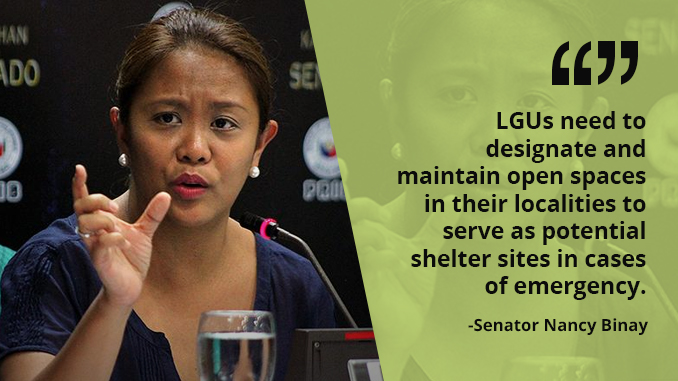Senator Nancy Binay today urged all local government units (LGUs) to explore the suitability of open spaces in their areas of jurisdiction where people can seek temporary shelter during and after an earthquake.
Binay added that LGUs need to designate and maintain open spaces in their localities to serve as potential shelter sites in cases of emergency.
“Ang mga designated na open spaces ay dapat na ma-maintain na open at walang mga structures upang maging kanlungan ng mga tao sakaling lumindol,” she said.
“Kailangan po ito lalung-lalo na sa mga matataong lugar tulad ng mga siyudad at iba pang highly urbanized areas,” Binay said.
According to the lady senator, LGUs must also provide residents and building owners a “quake assessment checklist” to guide them in the evaluation of their homes and buildings.
“Maaari pong gamitin ng mga residente ang self-assessment checklist na ginawa ng Phivolcs upang malaman kung safe ba o hindi ang mga tahanan nila,” Binay said.
“Libre naman ito at maaaring i-download (http://www.phivolcs.dost.gov.ph/images/Flyer-How-Safe-Is-Your-House.pdf),” she added.
The senator noted that local barangay executives should also help in identifying earthquake-prone areas and safe evacuation sites, and make the information available to everyone by way of signages, flyers, posters, and other forms of media.
“Maging aktibo po tayo sa information campaign at mas lalo pa po nating paigtingin ang mga quake drills upang maging pamilyar po ang ating mga nasasakupan sa mga procedures tulad ng duck-cover-hold at pag-evacuate tungo sa mga ligtas na mga lugar,” the lady senator said.
Binay added that LGUs should continuously prepare for earthquakes and check the soundness of all structures, especially old buildings, in their respective localities to determine if these can withstand earth movements.
“Ipinapakita lamang ng mga bumagsak na mga structures sa mga nagdaang lindol na kailangan paigtingin ang inspection ng mga LGUs sa mga structures, lalo yung mga luma na,” Binay said.
“Kailangan po itong tuloy-tuloy sa isang bansang earthquake prone tulad natin dahil na rin sa dami ng faults na dumadaan dito, tulad ng Philippine Fault at Valley Fault System (VFS),” she added.
A 2004 Japan International Cooperation Agency (JICA) report said that if the VFS generates a magnitude 7.2 earthquake in Metro Manila about 170,000 residential houses will collapse, 340,000 residential houses will be partly damaged, and 34,000 persons will die.
The same report said that 114,000 persons will be injured in the same earthquake.
Binay recalled that several structures, especially old churches and other public structures such as bridges either collapsed or sustained damage during the earthquakes that hit Bohol in 2013, in Surigao last February, and in Batangas last week.
“Kailangan na po nating laging paghandaan ang mga lindol o maging pre-emptive dahil hindi natin alam kung kailan ito tatama sa ating mga lugar,” Binay said.
“Maaari pong makipagtulungan ang mga LGU sa mga government agencies tulad ng DPWH at Phivolcs upang alamin ang mga risks at mga posibleng earthquake-related hazards sa kanilang mga lugar. Gamitin na rin ang mga mapang ibinigay ng MGB at Phivolcs upang laging maging handa,” she said.
“Pwede ring humingi ng tulong sa mga organisasyon tulad ng Philippine Institute of Civil Engineers (PICE) at Association of Structural Engineers of the Philippines (ASEP) upang ma-assess ang mga structures,” Binay added.

